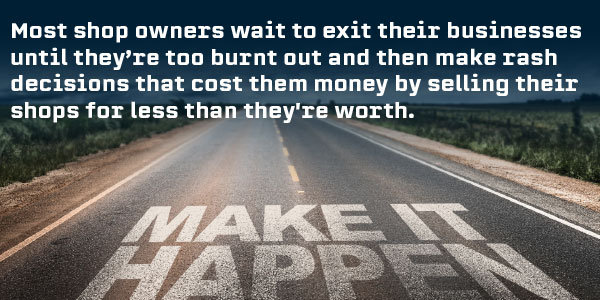A shop owner recently sent me this quote from Andrew Mayhew that really struck me, as it expresses what exit planning is all about: “Having an exit plan isn’t just about wanting to sell your business. It’s a contingency plan in case you ever NEED to sell your business.”
Two Thoughts
Shop owners typically begin thinking about the exit planning process when two streams of thought begin to converge. The first stream is a feeling that they want to do something besides go to work every day; either they would like to be someplace else doing something else, or they simply no longer get the same kick out of doing what they’re doing. The second stream is the general awareness of the following:
- They’re close to financial independence.
- They’re making significant strides toward reaching financial independence.
- They can achieve financial independence today by selling their businesses.
As these two streams converge, an owner’s thoughts flow inevitably toward exiting the business. As these two streams converge for you, will your business be prepared for your departure on your terms? Here is a typical scenario.
Pete told us that he wanted to leave his shop in five years by selling it for enough cash to maintain a comfortable post-exit lifestyle. A quick review of the company’s financials suggested that, with a current annual cash flow of $1 million (before Pete’s salary of $200,000), the shop’s estimated value was around $4 million.
When we suggested that he create and implement a step-by-step process to increase value, minimize taxes, protect existing value from loss and assure that his two key employees stay with the company after his exit, Pete agreed but did nothing more. He neither designed nor implemented an exit plan.
Five years later, Pete’s Collision Center was essentially unchanged, but Pete’s frustration had skyrocketed. Insurance labor rates, refusal of insurance companies to pay for proper repairs and increased administration had significantly affected business cash flow. Pete had reduced overhead but had done nothing to increase cash flow. For example, he had neither created and updated business systems (especially any marketing plan) nor restructured his inadequate and under-motivated management team.
Pete was still at least five years away from his exit.
Taking Action
Exit planning is more than thinking and talking — it’s taking the actions necessary to enable you to reach all your exit objectives. These objectives include leaving your business when you want, to the successor you choose, for the amount of cash you desire.
Furthermore, exit planning takes time. The further in advance you start planning for your exit, the more options you have and the better the outcome is likely to be. This is the biggest mistake shop owners make. Just like Pete, most shop owners wait until they’re too burnt out and then make rash decisions that either cost them money by selling their shops for less than they’re worth or not building enough value in these businesses to support the lifestyles they want. In many cases, they don’t consider their value-based goals like family considerations, the welfare of their employees or their impact on the community — and later regret the decisions they made.
Starting early and taking the time to properly put together an exit plan has several benefits:
- It allows you to accurately determine what you and your family’s goals are. Most families never take the time to sit down and discuss what each family member wants in life and then determine how they can work together to create a family legacy that supports these goals — which is why we like to hold regular family meetings to bring any issues to light and give the family the opportunity to create solutions that benefit it as a whole. Sometimes, parents think that the children will naturally take over the business and that they have the skills to successfully do so, as if they learned these through osmosis. Other times, they assume that the children have no interest in the business when, in fact, they do. I have one owner who had a son who had spent 16 years out on the shop floor, so the parents assumed he had no interest in running the day-to-day operations and began grooming their daughter to be the heir apparent. This caused a rift between the son, daughter and parents. Luckily, we had begun to run a series of family meetings to bring these issues to light and resolve them. I’ve also had cases where a child has no interest in the collision business but is passionate about something else. I had a client who had two sons in his business, and the general feeling was that they had to pass the shop to both. Unfortunately, the older son was not passionate about collision repair, and this was reflected in his attitude, which caused conflict between him and his dad. When we finally determined that his real interest was in excavating, we created a plan that allowed the family to help fund his excavating business as part of the “family umbrella” of entities. This is why we like to hold regular family meetings to bring any issues to light and give the family the opportunity to create solutions that benefit it as a whole.
- It allows you to accurately determine your employees’ goals. I’ve met numerous shop owners with loyal employees who are interested in and fully capable of running the shop. Sometimes, these employees can become the heirs apparent, especially if children are not interested in becoming the successors. I recently had a conversation with a shop owner who knew his children had no interest in the business and had created enough value in the business for it to be attractive to a third party. Yet, he wanted to take care of his employees who had been loyal to him. His shop is ideal for a plan that provides employee ownership either through a phantom stock program or an employee stock option program.
- It allows you time to build value in the business. Have you ever wondered why one shop has buyers lining up to pay top dollar while another sits on the market for months or years? What do buyers look for in a prospective business acquisition? The characteristics buyers seek are called value drivers, and they must exist before the sale process even begins. Value drivers are characteristics of a business that either reduce the risk associated with owning the business or enhance the prospect that the business will grow significantly in the future. It’s your job as the owner to create value within your business prior to a sale. Some of the most common value drivers include the following: stable and increasing cash flow (which can be used to help fund a family or key person sale or make the business more attractive to a third party); a stable, motivated management team; business systems that improve the sustainability of cash flows; a solid, diversified customer base; a business facility with a physical appearance consistent with the asking price; a realistic growth strategy; effective financial controls.
- It allows you to identify and address risks to your business and family. Even the best laid plans of mice and men can have wrenches thrown into them. Life is unpredictable. For many shop owners, the idea of business continuity planning, or plans that allow the business to continue should an owner become incapable of running the business (usually through death or permanent disability), is something they never want to think about. For most, the extent of their planning means simply signing a buy-sell agreement and filing it away. Unfortunately, most of these agreements never support an owner’s primary goals: namely selling the business when you want, for the amount you want, to the successor you want and ensuring your family is taken care of. Among the deficiencies they have are: they fail to address business challenges, such as the loss of capital and the loss of talent; they neglect the decedent’s family, especially in terms of their financial security; they are too simplistic and fail to adequately cover the effective transfer of the business; they ignore common lifetime exits, especially a right-to-first refusal; they use cookie-cutter valuation formulas; they’re outdated because they’re seldom reviewed; they’re poorly implemented, including not being signed, not reviewed in the last 10 years or more and/or are not properly funded.
While this topic will be covered in more detail in a later article, the key takeaway is that while continuity plans and buy-sell agreements play essential roles in achieving the goals of both the exiting and new owners, our experience has been that most continuity plans and buy-sell agreements fail on all counts.
Summary
Even if you have no intention of leaving your collision repair business soon, starting the planning process early will prepare you for the time that you want — and need — to exit. More importantly, it will give you a clearer idea of what you, your family and your key employees want and will make it easier for you to have that proper exit when the time comes, ensuring that your family is protected should an unexpected event occur.
We strive to help business owners identify and prioritize their objectives with respect to their businesses, employees and families. If you’re ready to talk about your goals for the future and get insights into how you might achieve those goals, we would be happy to sit down and talk with you. Please feel free to contact us at your convenience.















